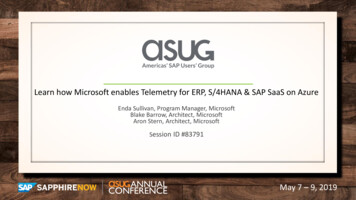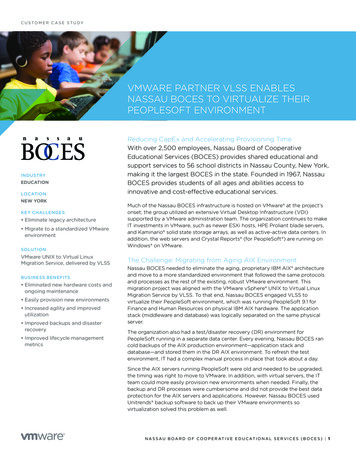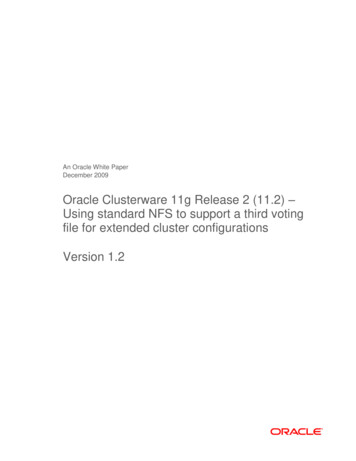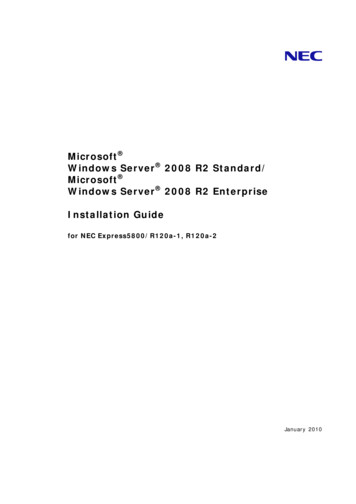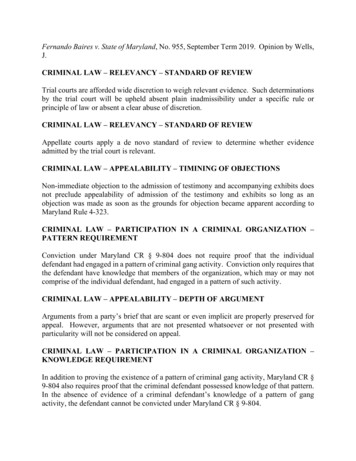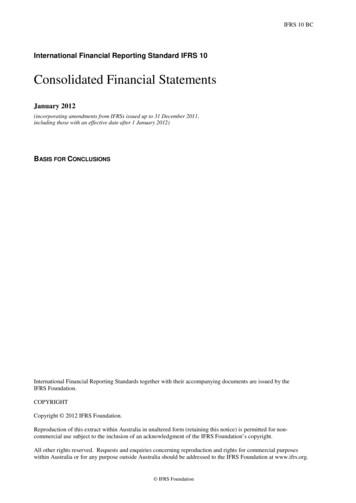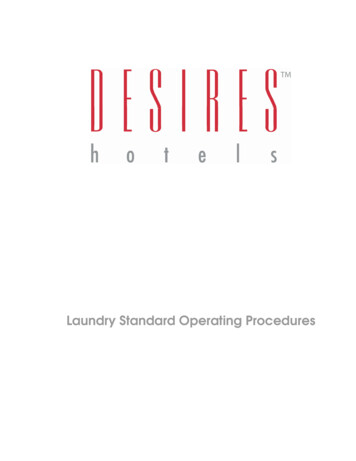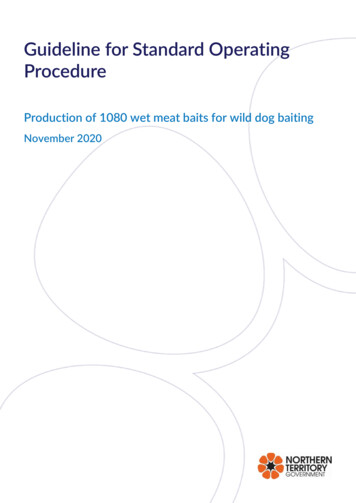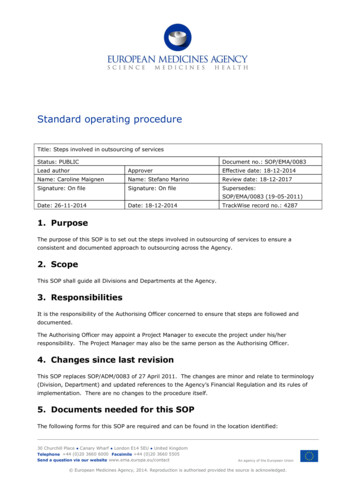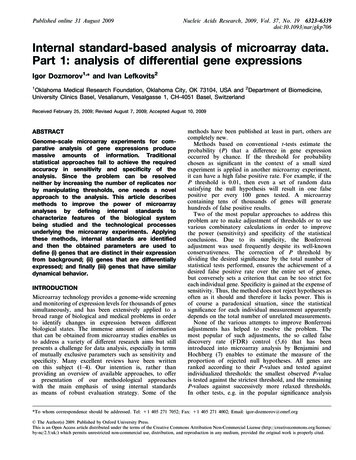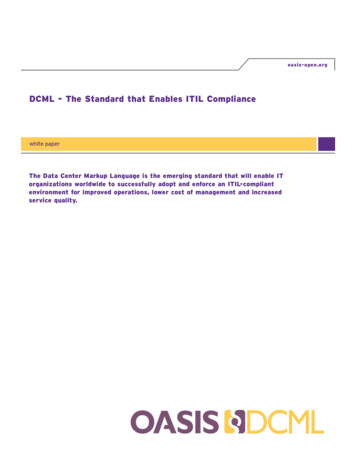
Transcription
oasis-open.orgDCML - The Standard that Enables ITIL Compliancewhite paperThe Data Center Markup Language is the emerging standard that will enable ITorganizations worldwide to successfully adopt and enforce an ITIL-compliantenvironment for improved operations, lower cost of management and increasedservice quality.
Table of ContentsIntroduction1IT Under Pressure1ITIL1Communication and ITIL Process1DCML2Use Cases3Incident Management3Configuration ManagementDatabase3Service Desk4Capacity Planning4Conclusion25
white paperIntroductionIT organizations, today, are struggling with how to decrease costs and increase service levels simultaneously. Implementing the ITILprocess is a way to achieve these cost and service levels goals. This paper describes how IT organizations can use the Data CenterMarkup Language (DCML) to facilitate low-cost, standards-based implementation of IT Infrastructure Library (ITIL) processes. ITILdefines a set of IT processes for service support and service delivery, providing a framework for best practice IT management. ITorganizations must find a way to take these guidelines, adapt them to their own environment, and make them actionable. DCMLdefines a standard messaging model for the exchange of information about IT infrastructure elements, applications, policies, bestpractices and standards. Together, DCML and ITIL can be used to achieve standard, best-practice IT management.Implementing each ITIL process often requires many IT management systems and organizations to communicate. ITIL processesthemselves must communicate with one another to achieve maximum benefit. While ITIL defines the processes and correspondinginformation flow, ITIL does not define what information flows where, how to represent information, or the method of communication. This has resulted in a wide collection of ad hoc and proprietary messaging strategies that are expensive to implement, support, and scale.By using DCML to formalize the data format used for ITIL communication, ITIL implementation becomes easier. Software vendorscan create management systems that are ITIL-ready out of the box. This enables easy integration between various systems andfacilitates and a smooth implementation of ITIL. IT professionals can learn standard skills that are applicable to different environments. DCML enables either internally developed or externally licensed management systems to achieve fully functional interaction immediately, providing data center operators the opportunity to achieve the cost and efficiency benefits of a unified IT architecture.IT Under PressureBusinesses continue to demand new andenhanced services from their IT organizations while simultaneously reducing themanagement resources available to IT. Atthe same time, IT is being crushed by theweight of the systems it has alreadydeployed. According to a recent Gartnerstudy, 80% of IT expenditures are non-discretionary, spent merely to keep existingsystems up and running. In addition, thepace of technology change and upgrademarches on, leaving IT with data centerscontaining a fast-growing mix of heterogeneous equipment, ranging in age and functionality, with ad hoc managementmethodologies, and little or no automation.As a result, IT complexity has explodedand data centers using traditional management methodologies are struggling to keepup with the demands of their users. ManyIT organizations have turned to automation to provide the operational agility andefficiency required to better meet thosedemands. Ad hoc management methodologies, while effective for a relativelysmall number of servers, are no longerviable for achieving the efficiencies man-dated by today's business requirements.While automation may solve part of thisneed, there needs to be more. In order toachieve maximum benefit from automation, IT organizations must have welldefined change processes to automate. Inorder for IT organizations to be effective,they must move away from ad hoc, manualmanagement, and towards a unified ITmanagement model, combining automatedmanagement with specific operationalbest practices and processes.ITILThe IT Infrastructure Library (ITIL) is a collection of books that define approximatelyten IT processes for IT service management and their operational characteristics.ITIL service management processes arebroken down into two broad areas: ITservice support and IT service delivery.ITIL processes require the support of andcommunication among OperationalSupport Systems (OSS) such as call center,ticketing, billing, provisioning, and monitoring. Addressing processes at the service level, ITIL provides a high-level description regarding how IT processes shouldmeet service requirements, but does not 1 address the specifics of how those services are implemented or delivered. As aresult, implementations of ITIL processesare subject to the inconsistencies of subjective interpretation.Communication and ITILProcessesAll ITIL processes have a similar understanding of data center infrastructure with eachprocess managing a different aspect of IToperations. The service desk process manages how users report problems and howthose problems are analyzed and corrected.The release process manages how new infrastructure and applications are introduced intothe IT environment. The change managementprocess manages how and when changes tothe IT environment are approved, implemented, and tracked. Other processes manageother aspects of IT service support and delivery.To be effective, these processes require communication and support from the variousOperational Support Systems (OSS) that ownthe required data. For example, the monitoring system knows which servers must be monitored, the provisioning system knows what
white paperstandardized communication mechanism isrequired. Only then can the true potential ofITIL be realized.DCMLRecognizing the need for a common dataformat among IT management systems,the IT industry created the Data CenterMarkup Language (DCML). Standardsbased and defined in human and machinereadable XML, DCML promotes data centerautomation by providing a uniform way fordata center automation and system management solutions to exchange information about the IT environment. The keybenefits of DCML to data center operatorsare: DCML enables ITIL implementation byproviding a formal syntax and semantics around the inter-system messagesthat define best practices for IT operations. By formalizing the messaging forITIL best practices, DCML gives ITorganizations a tangible step to taketowards a unified data center architecture helping them to implement bestpractices and automate data centeroperations.Figure 1: The DCML-ITIL Value Propositioninfrastructure has been provisioned, and thebilling infrastructure knows who uses specificparts of the infrastructure. All these systemshave their own area to manage and often needto interact with peer systems in order to complete their mission. For example, in provisioning a new business service, one must deploynew infrastructure and ensure the new infrastructure is monitored and billed appropriately.To achieve this, the provisioning system mustcommunicate with the monitoring system andthe billing system.Another example might be a company'smonthly billing cycle. During the month, a customer's business needs change, increasingand/or decreasing the resources they use. Tobill correctly, the billing system must communicate with the appropriate peer processes,like the metering system, which tracks usageof resources, or the change management system, to aggregate the appropriate information.Data centers looking to achieve the benefits ofbest practice operations have the option of inhouse implementation or outside license ofprocess-specific management systems. Towork together to implement ITIL processes,these systems must communicate.Traditionally systems have communicated innon-standard ways, typically using individuallycrafted Perl scripts and/or ad-hoc CSV-drivendata exchange. This non-standard genericcommunication between management systems severely inhibits the benefits of a unifieddata center architecture and hampers theimplementation of ITIL.Without a standardized communication protocol, the interfaces between peer managementsystems cooperating to implement an ITILprocess are unique, ad hoc entities. For thedata center, this translates into expensiveoperational overhead and the inflexibility ofmanagement system lock-in. For data centeroperators who want the flexibility to pick "bestof breed" solutions from a robust multi-vendormarket of ITIL-based management systems, a 2 DCML allows for an open and competitive market for products that conformto ITIL best practices. As a standardsbased technology using XML, IT technology vendors are migrating theirproducts to support DCML. As a result,data center operators will be able to:- Choose best of breed applicationsand avoid being locked in to highoverhead and/or inefficient proprietary or ad hoc tools.- Increase the quality and reduce theoverall costs of IT operations.- Have access to a larger communityof trained IT staff.- Reduce the need to develop inhouse applications to support ITILprocesses.DCML provides interoperability and renders proprietary approaches obsolete bydefining a systematic, vendor-neutral wayto communicate the environment and policies governing the construction and management of IT infrastructure. Managed bythe Organization for the Advancement ofStructured Information Standards (OASIS),
white paperFigure 2: Common ITIL Processes for service supportthe DCML initiative is currently backed byover sixty IT users and vendors includingComputer Associates, EDS, Opsware,TIBCO, BEA, and Mercury Interactive.Use CasesPerhaps the best way to understand howDCML enables ITIL implementation is toexamine some detailed use cases. The following sections do just that for some common ITIL processes, drilling down on howDCML is used to facilitate ITIL and thebenefits achieved.Incident ManagementITIL requires the change managementprocess to communicate context andchange information to a monitoring systemresponsible for monitoring the data centerenvironment. The mission of the monitoring system is to ensure that the data center infrastructure is operational and functioning properly. If an issue arises with aserver or application, it is the monitoringsystem's responsibility to identify the issueand report it to the network operationscenter (NOC). IT personnel (or in somecases automated systems) then determinethe cause of the incident and the requiredfix. An important step in the process isdetermination of the incident's root causewhether there is a systematic change thatcan be made to prevent the incident fromhappening again.Today the typical messaging architecturebetween these IT processes is often eitherembedded in ad hoc Perl scripts or vendorproprietary products. DCML allows datacenter staff to choose change managementand monitoring applications from differentvendors, freeing them from internal development or lock-in to a single proprietaryvendor. Moreover, IT product vendors willhave to compete for the data center'schange management and monitoring system business by lowering prices andincreasing functionality in an open standards-based marketplace. This will resultin increased quality and reduced costs tothe data center in implementing automatedmechanisms supporting the change management and monitoring functions.Operationally, NOC personnel can useDCML-encoded context information provided by the change management system tohelp deduce the likely root cause for anoutage. Such information might include theowner of an application service, the timeand date the last change to the service wasmade, and the versions of various installedOS and software application components.Using DCML, NOC personnel can populate atrouble ticket to track and resolve the incident, listing the required fix or work aroundalong with other relevant information suchas the current context of the machine. Indetermining the root cause of an outageand subsequently ensuring that similarincidents do not occur, IT administratorscan access information from other ITILprocesses to augment their own internalinformation. In this way, the proper information is brought to bear easily from anumber of ITIL-based applications, improving the decision making process and speeding time to repair. 3 Configuration ManagementDatabaseA key component of ITIL is the centralConfiguration Management Database(CMDB), used for enterprise reporting anddecision support, by storing a variety ofConfiguration Items (CIs) about the IT environment. The information required to populate the CMDB resides in various management systems across the enterprise, used fordifferent purposes such as purchasing, ERP,monitoring, asset management, ticketing,and provisioning.Under traditional non-standard messagingarchitectures, the interfaces to these systems are either proprietary or developed adhoc by the IT staff. Interfacing to them istypically time-consuming, non-scalable, andcostly, requiring the development of uniqueintegration software. Because of these limitations, while a CMDB is helpful in achievingimportant business goals, the overheadinvolved in its implementation often makesits development too costly to be practical.With DCML-compliant management systems,a standard mechanism for gathering CMDBinformation can be put in place. The popularity of ITIL and the CMDB, a marketplace forDCML-compliant CMDBs from third partyvendors is emerging. In a DCML standardsbased world, CMDB-based enterprise reporting and decision support solutions: are available at a lower cost; require a significantly lower learning curveto install, integrate, and operate; are available as either a standalone thirdparty application or third party integration
white papercomponents that ease the development ofspecific in house applications; and are useful for sharing information withpartners and suppliers.Service DeskThe service desk within a data center isoften "the canary in the coal mine," givingIT staff its first indication of problems withthe services they provide. In hindsight,many organizations who have suffered significant outages can go back, review theservice desk requests, and see the seedsof those problems in their logs.To minimize these disruptions, manyexpert service desks conduct root causeanalysis on the requests they receive during problem management and try to correlate those requests to identify relatedproblems. The goal of this exercise is toprevent future incidents by removing theroot cause(s) of problems. Much of therequired information resides within different IT systems, making the effectivenessof root cause analysis dependent on thebreadth of access to these diverse applications. The quality of root cause analysis isdirectly related to the available budget formanagement system integration. Withproprietary and/or ad hoc messagingarchitectures, integration is costly, timeconsuming, and non-scalable. As a result,non-standard messaging architecturesseverely restrict the quality of from theresulting root cause analysis.With the adoption of a DCML-compliant ITinfrastructure, a standard messaging interface is available for every ITIL application,greatly reducing the cost and increasingthe effectiveness of root cause analysis.A DCML-compliant infrastructure providesthe root-cause analysis function withaccess to a unified information repository,allowing efficient correlation of commonlyoccurring incidents. With access to all thepertinent facts, a root cause analysis function can provide a high quality resolutionto an incident quickly and effectively anddo so at low integration cost.Capacity PlanningCapacity Management is an ITIL servicedelivery function that ensures IT organizations provide sufficient computingresources to meet the needs of a givenbusiness service.With IT budgets under the microscope,many organizations have reduced ITexpenditures over the past several years,even as the number of applications hostedor supported has grown tremendously.Faced with reduced headcount anddecreasing or flat budgets, CIOs are undertremendous pressure to use their existingequipment to the fullest. In order for anorganization to use its resources effectively, it must manage those resources in realtime, always knowing which resources areavailable, in use, and scheduled to be available at a future date and time.Organizations must also anticipate futureresource demand based on trends definedby past usage and new requirements.Most organizations today do not havetools that can deliver true CapacityManagement functionality. ITIL calls for aCapacity Database (CDB) function thatacts as a Decision Support System (DSS)for capacity planning. IT organizations utilizing these tools today are often lockedinto a single proprietary solution thatoften does not integrate with theDefinitive Software Library (DSL),Definitive Hardware Library (DHL) and/orother components of ITIL. The result isthat IT professionals are left to performingthis integration by ad-hoc means.Proprietary CDB vendors have also beenslow to incorporate support for newlyreleased server and network componentsinto their products.Using DCML as the standard data formatIT organizations can ensure that the rightdata is stored in and accessible in the CDB.Powerful DCML-compliant capacity modeling tools and/or pluggable modules areemerging to work with the CDB. This willensure that IT organizations will: have many CDB vendor choices, be able to leverage data regardless ofwhere it resides in the IT environment,and easily model the effects of the removalof legacy equipment along with theaddition of newer infrastructure.Figure 3: More in-depth breakdown of how DCML benefits a common ITIL Process 4
white paperConclusionTo keep their companies competitive, ITmanagers are under tremendous pressureto increase efficiency and lower the cost ofIT operations. By defining a set of operational processes, the IT InfrastructureLibrary (ITIL) is quickly becoming the basisfor IT managers to achieve best practiceoperations. A best practices guideline, ITILallows data center operators to begin realizing the efficiencies of a unified data center architecture. ITIL is the best choiceavailable to IT managers to reduce theiroverall costs while simultaneously increasing service levels.ITIL defines data center operation as a federated group of cooperative processesworking together to achieve common goals.Because ITIL does not define a standardmessaging protocol, communicationbetween ITIL-compliant applications isthrough either ad hoc or proprietary mech-anisms. This adds significant implementation cost overhead and severely limits ITorganizations in their technology choices.This lack of standards-based communication inhibits the move to process automation, further hampering overall IT performance and efficiency.DCML significantly eases ITIL implementation by formally defining the syntax andsemantics of applications supporting theITIL process. By standardizing the dataformat among management systems integral to ITIL processes, an open and competitive market for those systems isemerging - increasing the quality andreducing the cost of implementing datacenter best practices.and is supported by over sixty active ITapplications from an open and competitivemarket, integrating those applications intotheir environment out of the box. DCMLhelps make ITIL a commercial reality, providing IT managers the mechanism toimplement best practice operations andachieve the benefits of a unified data center architecture. For more informationabout DCML, please ask your IT technologyvendor about their DCML roadmap or contact OASIS directly for more informationabout DCML, events, and membership.The leading standard for enabling ITILdefined best practices, DCML is managedby the international standards body, OASIS,user and vendor members. With DCML, ITAbout OASISAbout OASISOASIS (Organization for
Computer Associates, EDS, Opsware, TIBCO, BEA, and Mercury Interactive. Use Cases Perhaps the best way to understand how DCML enables ITIL implementation is to examine some detailed use cases. The fol-lowing sections do just that for some com-mon ITIL processes, drilling down on how D

